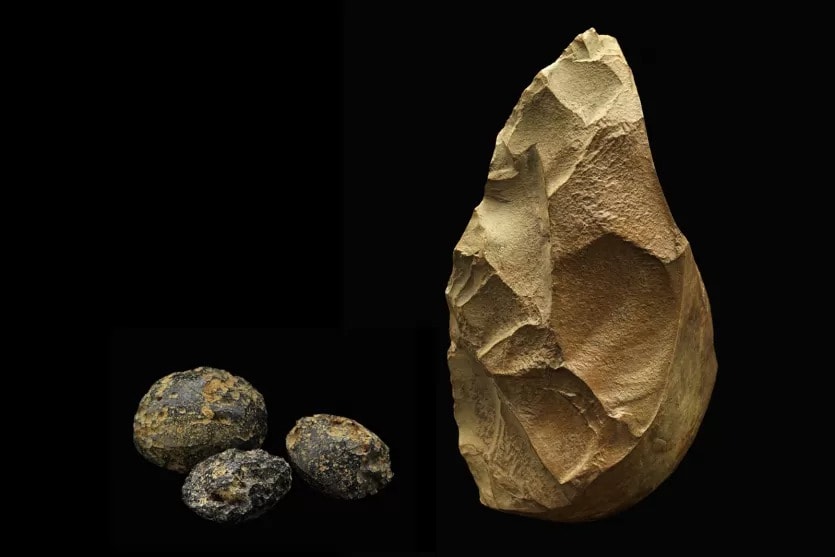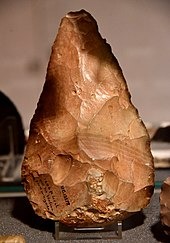Stone tools are some of the most basic human inventions. They’re also some of the oldest, with some archaeologists claiming that they date back as far as 3.3 million years ago. These crude lumps of rock with one useful corner and a lot of useless edges weren’t just crude lumps of rock with one useful corner and a lot of useless edges; they were cunningly engineered tools with multiple uses.
The fact that these simple tools were invented so long ago confirms what we know about early humans: they were much smarter than we give them credit for! Let’s take a closer look at these seven oldest stone tools ever found.
7. Bose’s Hand Ax and Tektites
Age: About 803,000 years old
Site: Bose, China
Year Discovered: 1996
Discovered By: A team led by Hou Yamei and Rick Potts

Hand axes and tektites of Bose are two items that are well-known for their production in Bose, China. These two items are both highly prized by collectors.
Hand axes are a type of tool that has been used by humans for millions of years. They are made by chipping away at a piece of stone until it has the desired shape. Tektites are a type of natural glass that is formed when meteorites hit the Earth. They are also found in areas where there have been a lot of volcanic activity.
Bose hand axes and tektites are some of the most sought-after examples of these items. They are known for their high quality and craftsmanship. Many collectors consider Bose hand axes and tektites to be the best of their kind.
6. Stone Hand Axes from India
Age: About 1.1 million years old
Site: Isampur, India
Year Discovered: 1863
Discovered By: Robert Bruce Foote and W. King

Stone hand axes from India are some of the oldest artifacts in the world. They date back to the Lower Paleolithic period, which means they are at least 200,000 years old. The fact that they have been found in India is significant because it indicates that early humans were living in this region of the world much earlier than previously thought.
These hand axes were probably used for a variety of tasks, including chopping wood, butchering animals, and even as weapons. They are made from a variety of materials, including granite, limestone, and sandstone. The fact that they were created by early humans is a testament to their ingenuity and resourcefulness.
Today, these stone hand axes are a valuable part of the world’s heritage. They provide us with a glimpse into the lives of our earliest ancestors and offer insights into the evolution of human beings.
5. Majuangou Hammerstone
Age: About 1.66 million years old
Site: Majuangou, Nihewan Basin, China
Year Discovered: Unspecified
Discovered By: A team led by R. X. Zhou and Rick Potts

Research suggests that early people migrated from Africa to other regions of the globe more than a million years ago. They arrived in China around 100,000 years ago, when humans were just beginning to develop a sense of social organization.
Researchers at the Human Origins Program, in association with the Chinese Academy of Sciences and Hubei Institute of Cultural Relics, discovered animal tracks and stone tools like this hammerstone at excavation sites in China’s Nihewan Basin.
4. Acheulean Axes
Age: About 1.76 million years old
Site: Africa, Israel, and China
Year Discovered: 1859
Discovered By: John Frere

The Acheulian is a period of the Lower Paleolithic associated with the earliest known hand axes. The Acheulean is characterized by a distinctive style of stone tool manufacture known as the Acheulean technique. This technique involved shaping a stone core or cobble into a bifacial hand ax, a large, teardrop-shaped tool with a sharpened edge on each side. Acheulian axes are some of the most abundant and widely distributed artifacts from the Lower Paleolithic.
They have been found on every continent except Antarctica. Acheulian axes have been particularly well-studied in Africa, where they are thought to have originated. African Acheulian axes are typically larger and more crudely made than those from other regions. Acheulian axes were some of the first tools to be manufactured using the Acheulean technique.
This technique involved shaping a stone core or cobble into a bifacial hand ax, a large, teardrop-shaped tool with a sharpened edge on each side. Acheulian axes were used for a variety of tasks, including chopping, cutting, and scraping.
3. Olduvai Stone Chopper
Age: About 1.8 million years old
Site: Olduvai Gorge, Tanzania
Year Discovered: 1931
Discovered By: Louis Leakey

The Olduvai Stone Chopper is a tool that was used by early humans during the Olduvai Gorge period that was discovered in the Olduvai Gorge in Tanzania. It is believed to be about 1.8 million years old and is one of the oldest examples of a stone tool that has been found. The chopper was likely used for chopping wood or other materials.
The chopper is a small, handheld tool that is used to chop up meat and other food items. The chopper is made of a sharpened piece of stone that is attached to a wooden handle. The chopper was found in the Olduvai Gorge region of Africa, which is where the first humans are thought to have originated.
2. Oldowan Tools
Age: About 2.3 million years old
Site: Lokalalei, Kenya
Year Discovered: 1997
Discovered By: A team led by Helene Roche and Mzakendo Kibunjia

Oldowan tools are some of the earliest known tools used by humans. They were first discovered in the early 20th century in Africa, and more specifically in the Lokalalei region of Kenya. The name “Oldowan” comes from the site where they were first found.
Oldowan tools are typically made of stone and consist of a simple core and one or more flakes. The flakes are usually made of quartz or another hard stone, and they were probably used for cutting and scraping. The cores, on the other hand, were probably used as hammerstones.
Oldowan tools are generally very simple, and are thought to be among the first tools used by humans. This is supported by the fact that they have been found in Africa, which is considered the birthplace of humanity.
1. Kenya’s Cutting Stone Tools
Age: About 3.3 million years old
Site: Lake Turkana, Kenya
Year Discovered: 2015
Discovered By: Michael Balter

Kenya’s cutting stone tools are the oldest stone tools ever discovered, dating back over 3.3 million years ago. The tools were discovered in 2015 by Michael Balter and have since been extensively studied by archaeologists.
These stone tools are simple hand-held stones that were used for a variety of tasks, including chopping and scraping. They are believed to have been used by early humans in Kenya to process food, make clothing, and build shelters.
They are an important discovery because they provide insight into the cognitive and technological development of early humans. The fact that these tools were used over 3 million years ago suggests that early humans were capable of complex thought and planning and that they had developed sophisticated tool-making skills.











